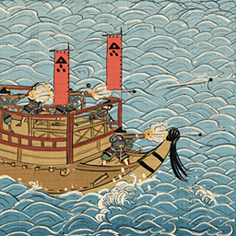
Basic Unit Statistics (can be modified by difficulty level, arts, skills, traits and retainers)
| Recruitment Cost | 150 | |
| Upkeep Cost | 100 | |
| Marines | 30 | 25% |
| Seamen | 5 | 2% |
| Hull Strength | 100 | 1% |
| Morale | 12 | 24% |
Strengths & Weaknesses
- Fast moving.
- Matchlocks deadly against crew and can also damage hull.
- Vulnerable if boarded.
- Crew very exposed to missiles.
Abilities
- Battle Speed - This increases a ship's rowing speed for a short period of time.
Requires
Description
This light ship only carries a small number of warriors each armed with a deadly matchlock arquebus.
A matchlock ship carries a small detachment of musket-armed soldiers, certainly not enough to fend off a boarding action, although the Otomo's Christian fervour and familiarity with matchlocks enables them to shoot more accurately and reload at a faster rate than other troops of the same class. Further, because the upper deck has no cover, they are exposed to missile attacks. However, this lack of fighting manpower and protection also makes the ship very light and fast. The matchlock troops can fire at an enemy crew or at the side of an enemy ship in an attempt to hole it. If a heavy enemy vessel gets too close and a boarding attack looks likely, a matchlock ship can use speed to move out of trouble and continue its harassing attacks. Coming to prominence during the Kamakura Shogunate following the Gempei War, the Otomo clan remained at the forefront of feudal politics for the next four hundred years. Alongside the Shimazu, the Otomo were one of the largest clans on Kyushu, and had early contacts with the Portuguese, soon establishing trade links. Their daimyo, Otomo Sorin, saw the benefits to the clan's prosperity and wanted the emerging gun technology that European trade could bring. Following the arrival of the Jesuit missionary Francis Xavier in 1549, and his subsequent meeting with the daimyo, Otomo Sorin showed tolerance towards the Jesuit conversion of Japanese subjects to Catholicism, eventually converting himself in 1578. During the Sengoku Jidai, the Otomo fought against both the Shimazu and the Mori clans. They retained control of their lands into the Edo Period by playing a minor role during Tokugawa Ieyasu's Sekigahara Campaign.